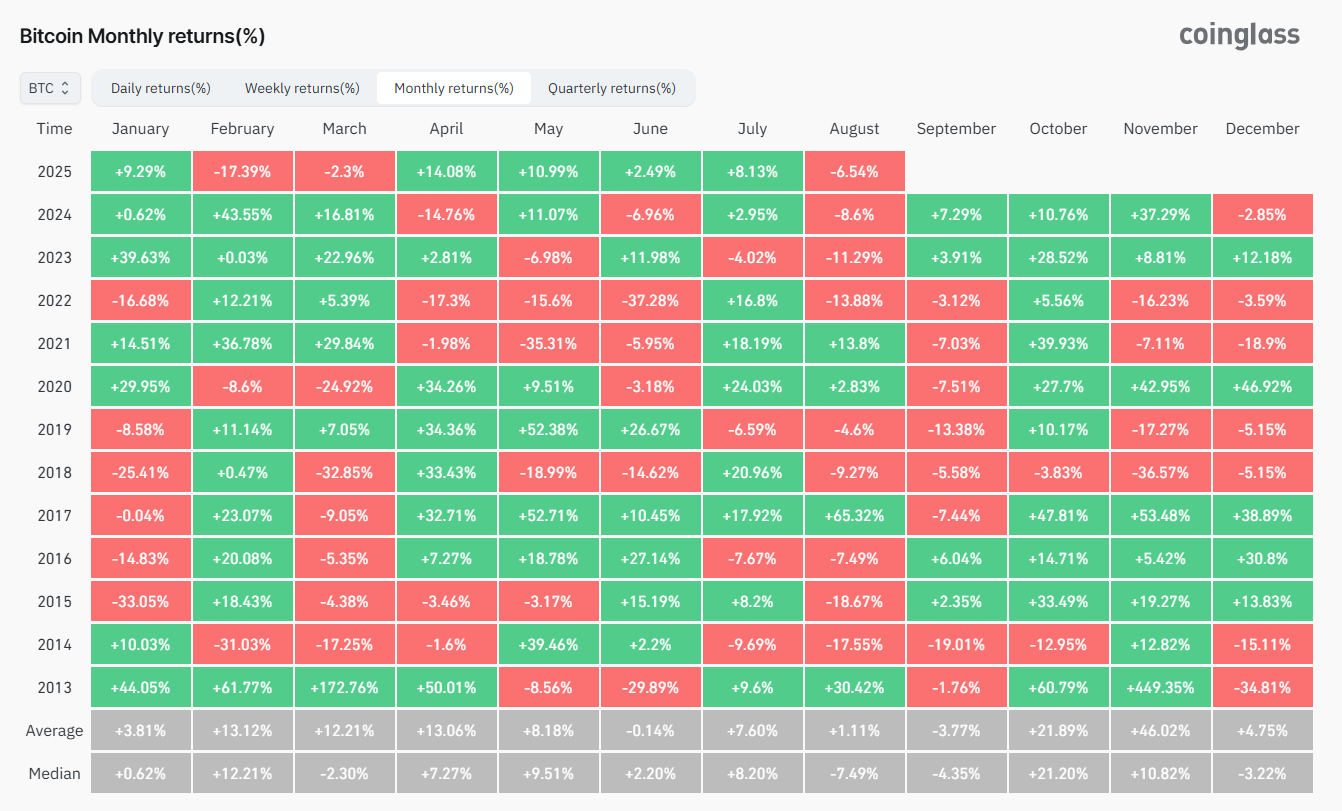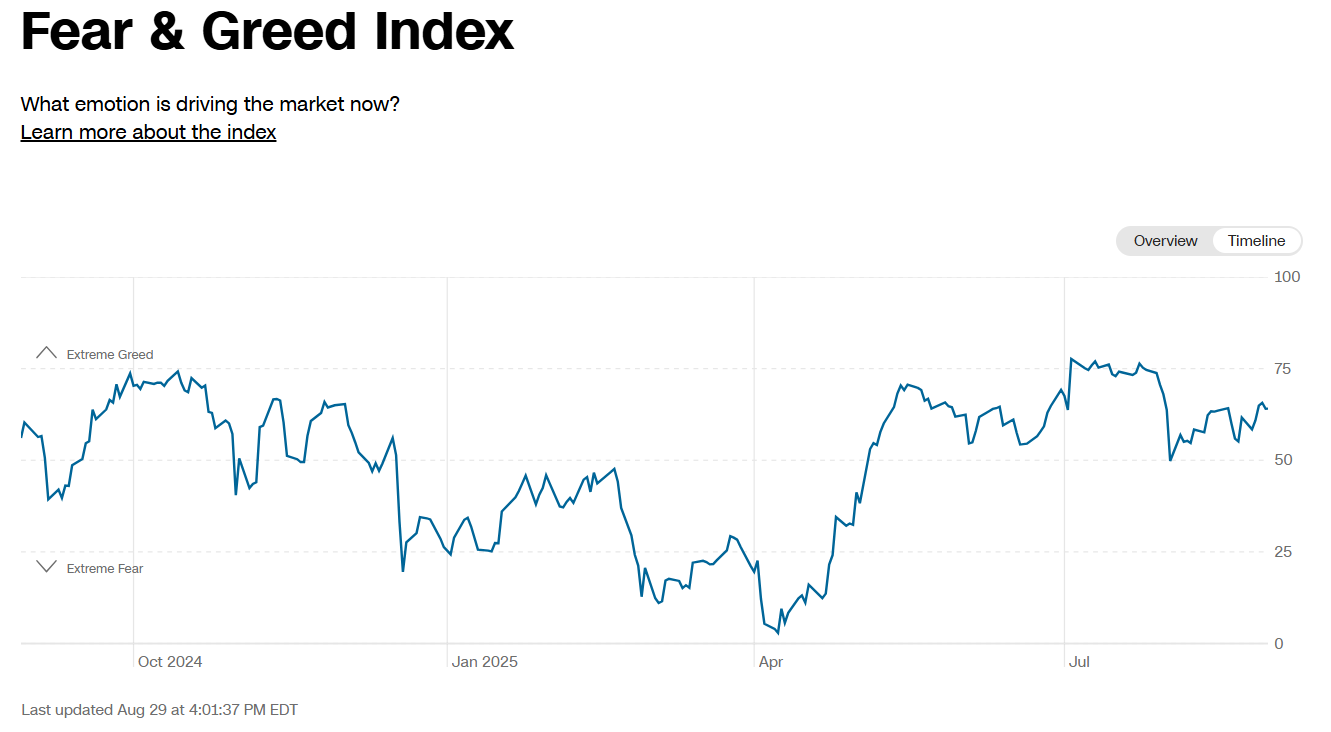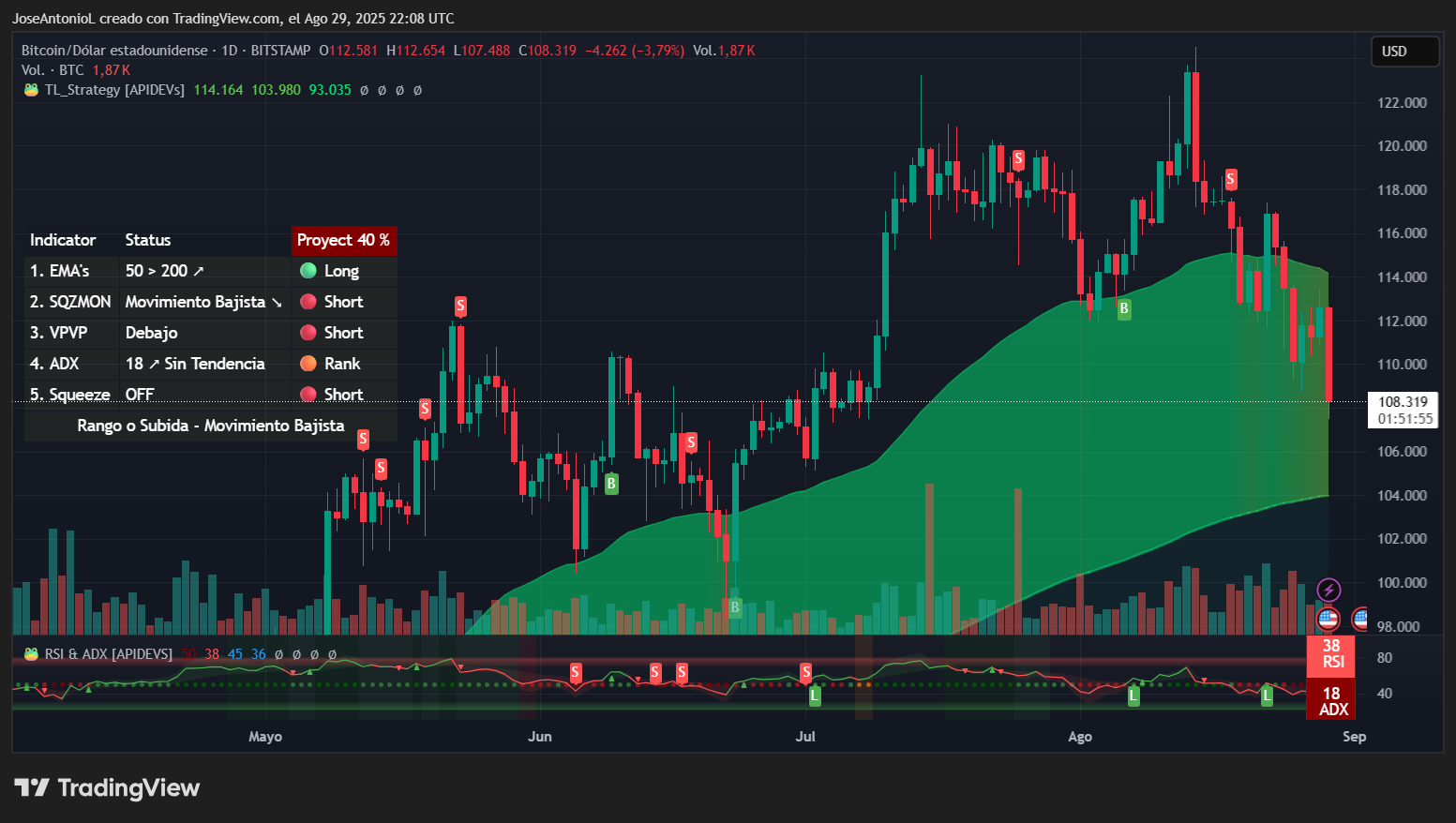Bitcoin is trading sideways as August winds down, and crypto traders are doing what they do every year around this time: preparing for pain.
The phenomenon known as "Red September," or “The September Effect,” has haunted markets for nearly a century. The S&P 500 has averaged negative returns in September since 1928, making it the index's only consistently negative month. Bitcoin's track record is worse—the cryptocurrency has fallen an average of 3.77% each September since 2013, crashing eight times according to data from Coinglass.
"The pattern is predictable: negative social media chatter spikes around August 25, followed by increased Bitcoin deposits to exchanges within 48-72 hours," Yuri Berg, a consultant at the Swiss-based crypto liquidity provider FinchTrade, told Decrypt.
"Red September has gone from market anomaly to monthly psychology experiment. We're watching an entire market talk itself into a selloff based on history rather than current fundamentals."

Image: Coinglass
The mechanics behind Red September trace back to structural market behaviors that converge each fall. Mutual funds close their fiscal years in September, triggering tax-loss harvesting and portfolio rebalancing that floods markets with sell orders. Summer vacation season ends, bringing traders back to desks where they reassess positions after months of thin liquidity. Bond issuances surge post-Labor Day, pulling capital from equities and risk assets as institutions rotate into fixed income.
The Federal Open Market Committee holds its September meeting, creating uncertainty that freezes buying until policy direction clarifies. In crypto, these pressures compound: Bitcoin's 24/7 trading means no circuit breakers when selling accelerates, and a smaller market cap makes it vulnerable to whale movements seeking to rotate profits into altcoins.
The cascade starts in traditional markets and spills into crypto within days. When the S&P 500 drops, institutional investors dump Bitcoin first to meet margin calls or reduce portfolio risk. Futures markets amplify the damage through liquidation cascades—a 5% spot move can trigger 20% in derivatives wipeouts. Social sentiment metrics turn negative by late August and traders sell preemptively to avoid expected losses. Options dealers hedge their exposure by selling spot Bitcoin as volatility rises, adding mechanical pressure regardless of fundamentals.
And just like any other markets, some believe this becomes a pattern out of pure rational expectation, which is just another way to say self-fulfilling prophecy.
The numbers back up Berg's observation. The Crypto Fear and Greed Index has dropped from 74 out of 100 to 52, despite the global stock market showing a more optimistic view with 64 points. Borderline neutral but still in the “greed” zone.

Image: CNN
But this September arrives with unusual crosscurrents. The Federal Reserve has shared positive statements, with the market pricing in another cut for the September 18 meeting. Core inflation remains stuck at 3.1%, while two active wars disrupt global supply chains. These conditions create what Daniel Keller, CEO of InFlux Technologies, sees as a perfect storm.
"We have two history-defining theaters of combat, one in Europe and one in the Middle East, which are disrupting critical supply chains," Keller told Decrypt. "Additionally, the U.S. has initiated a global trade war against nearly all of its major allies. The contemporary state of global geopolitics perfectly positions BTC for a steep decline come September 2025."
In other words, right now markets don’t see Bitcoin as a hedge, which was the dominant pre-COVID narrative of BTC as an asset. Markets view it much more like a risk asset.
Technical indicators are starting to paint a scary picture for traders. Bitcoin broke below the critical $110,000 support level that has anchored the rally since May. The 50-day moving average sits at $114,000 and is now acting as resistance with the 200-day EMA providing support near the $103K price line.

Technical traders might be watching $105,000 as the line in the sand. On Myriad, a prediction market developed by Decrypt's parent company Dastan, traders currently place the odds of Bitcoin dipping back down to $105,000 at nearly 75%.
A break below $105K would target sub-100K levels below the 200-day moving average. Hold above $110,000 through the first two weeks of September, and the seasonal curse might finally break.
The relative strength index reads 38, in oversold territory implying at least some Bitcoin investors are trying to get rid of their coins ASAP. Volume remains 30% below July averages, typical for late-summer trading but potentially problematic if volatility spikes.
But even if things seem like traders are preparing for history to repeat itself, some believe Bitcoin’s fundamentals are now stronger than ever, and that should be enough for the king of crypto to overcome this difficult month—or at least not crash like it has in the past.
"The idea of 'Red September' is more myth than math," Ben Kurland, CEO at crypto research platform DYOR, told Decrypt. "Historically, September has looked weak because of portfolio rebalancing, fading retail momentum, and macro jitters, but those patterns mattered when Bitcoin was a smaller, thinner market."
Kurland points to liquidity as the real driver now. "Inflation isn't gliding lower, it's proving sticky with core readings still creeping higher. But even with that headwind, the Fed is under pressure to ease as growth cools, and institutional inflows are deeper than ever."
Traditional warning signs are already flashing. The FOMC meets September 17-18, with markets split on whether officials will hold rates or cut them.
Keller advises watching fear and greed indices closely. "Traders in the coming weeks should monitor fear and greed indices to determine the general market sentiment and whether it's better to hold in case prices jump or sell off as 'Red September' looms closer," he said.
The seasonal pattern may be weakening as crypto matures. Bitcoin's September losses have moderated from an average negative 6% in the 2010s to negative 2.55% over the past five years. Institutional adoption through ETFs and corporate treasuries has added stability. In fact, in the last two years, Bitcoin has registered positive gains in September.
Berg sees the whole phenomenon as self-reinforcing psychology. "After years of September selloffs, the crypto community has trained itself to expect weakness. This creates a cycle where fear of the dip becomes the dip itself," he said.
It the outlook seems bleak, don’t fret: After Red September comes October—or “Uptober”—which is historically Bitcoin’s best month of the year.
The views and opinions expressed by the author are for informational purposes only and do not constitute financial, investment, or other advice.
免责声明:本文章仅代表作者个人观点,不代表本平台的立场和观点。本文章仅供信息分享,不构成对任何人的任何投资建议。用户与作者之间的任何争议,与本平台无关。如网页中刊载的文章或图片涉及侵权,请提供相关的权利证明和身份证明发送邮件到support@aicoin.com,本平台相关工作人员将会进行核查。



